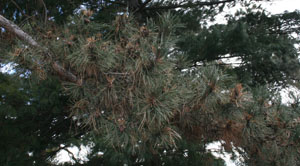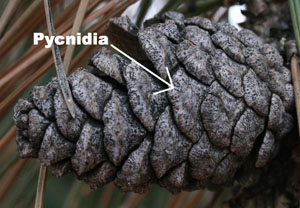G1845
Sphaeropsis Tip Blight of Pine
Browning and death of tips is quite common in older, well-established pine plantings. Such damage is often due to Sphaeropsis tip blight, a fungal disease caused by Sphaeropsis sapinea. This NebGuide discusses the description, symptoms and management of Sphaeropsis sapinea pine.
Amy D. Ziems, Extension Educator—Plant Pathology
Introduction
Browning and death of branch tips, common in older, well-established pine plantings, is often due to Sphaeropsis tip blight (also known as Diplodia tip blight), a fungal disease caused by Sphaeropsis sapinea (syn. Diplodia pinea). Infection kills major branches and may even kill the entire tree under high disease pressure.
Sphaeropis sapinea can infect young trees too, but the disease becomes increasingly more common and destructive as trees approach 30 years of age. Tip blight commonly occurs in landscape, windbreak and park plantings, but seldom found in natural pine stands. Several pine species can be infected. In this region the disease is most severe on Austrian pine (Pinus nigra) and ponderosa pine (P. Ponderosa), but it can also damage Scotch pine (P. sylvestris) and mugo pine (P. mugo).
Symptoms and Damage
The most conspicuous symptom of Sphaeropsis tip blight is new shoots with short, brown needles (Figure 1). Needles of infected new shoots become tan to brown in color while still encased in fascicle sheaths. Entire new shoots are killed rapidly.
Damage is typically confined to new shoots, particularly on trees infected for the first time. As pines grow, the candles (new growth) extend across the entire tree. Thus damage can occur throughout the entire tree (Figure 2). Damage in the lower portion of the tree is related to (in many cases) moisture which is higher in the lower region of the canopy. After repeated infections, the tree will have not only dead new shoots, but also dead needles on older shoots.
 |
 |
|
| Figure 1. Dead, stunted needles at branch tips. | Figure 2. Short, brown needles confined to new growth on a branch. |
Disease severity can vary considerably among major branches of the tree. Occasionally, after two or three successive years of infection, there can be extensive damage and death at the top of the tree. Death of older tissue may be so extensive that branches are killed back to the main stem. Following repeated infections, there is reduced growth, deformity of trees, and subsequent tree death.
Small black fruiting bodies called pycnidia, in which spores of S. sapinea are produced, develop on needles, fascicle sheaths, scales of second-year seed cones, and bark. The fruiting bodies can be seen with the naked eye or a 10x hand lens. Pycnidia are usually numerous at the base of needles and are easily found on the short needles of shoots infected the previous year. This will be more evident on those needles that have turned ash-gray and are easily detached. The pycnidia can also be easily found on the scales of second-year seed cones (Figure 3).
The presence of dead new shoots with stunted needles and small, black fruiting bodies at the base of the needles and on cone scales are diagnostic of Sphaeropsis tip blight. The disease may be confused with damage to shoots caused by pine tip moths; however, moth damage may be identified by the presence of larvae or by tunnels within the affected part of the shoot (Figure 4).
 |
 |
|
| Figure 3. Fruiting bodies (pycnidia) on infected seed cones. | Figure 4. Pine tip moth larvae and tunnel found in a pine shoot. (Courtesy J. Kalisch, University of Nebraska–Lincoln). |
Disease Cycle
|
The formation of pycnidia on cones and needles is dependent upon rainfall. When rainfall is above normal in late summer, numerous pycinidia develop on infected first-year needles and on second-year seed cones. During years of normal rainfall, pycnidia are not numerous on needles and cones until the following spring.
Spores (Figure 5) produced in the pycnidia are dispersed primarily by rain splash. Infection requires very moist conditions and high relative humidity. Low moisture and humidity levels occurring when new shoots are highly susceptible usually results in low infection rates.
Infection of current-year shoots occurs from April to mid-June; however, new shoots are most susceptible during the first portion of candle elongation. (Pine new growth is usually referred to as candles). Tip dieback symptoms on new shoots can be seen by late May, with the extent of infection becoming evident in late June or July.
Second-year cones are initially infected in late May. Numerous pycnidia develop in infected second-year cones and the increased damage to older trees is probably related to this fungus buildup. Infected seed cones often are observed on otherwise healthy pines, indicating that the fungus builds up on seed cones of older pines before new shoots are extensively infected.
Infection of new shoots occurs in the absence of wounds. However, older shoots and branches may become infected when tissues are injured by insects, hail, or pruning. In naturally forested areas, tip blight is common following severe hail injury to trees.
The low level of infection on young trees is attributed to the limited number of cones produced, which limits spore inoculum. Young trees adjacent to older, cone-bearing pines can be infected by inoculum produced on the cones of the older trees.
Management
Removing infected branches and tips through pruning will improve the aesthetic quality of trees, but will do little to reduce disease spread since the major source of inoculum is infected seed cones that may remain on the tree.
Avoid pruning or shearing in Christmas tree or other pine plantings when conditions favor infection due to the danger of infection through wounds.
It has been shown that infection of new shoots can be reduced significantly with fungicidal treatment applied twice during the period when current-year shoots are most susceptible. This period begins with the opening of shoot buds and extends for about two weeks. In Nebraska, the first application is typically made during the third week in April and repeated the first week in May, provided optimum disease control in most years. Fungicides applied after mid-May are usually ineffective. Depending on the product being used, recommended fungicide timing may differ from above. Read and follow all label directions carefully before making any applications (Table I).
| Table I. Fungicides* available for Sphaeropsis tip blight control. | |||
| Fungicide Active Ingredient | Trade Name | Aerial Application |
Commercial (C)/ Homeowner (H) Use |
| Chlorothalonil + Propiconazole | Concert (Syngenta) | No |
C |
| Chlorothalonil + Thiophanate-methyl | Spectro 90WDG (Cleary) | No |
C |
| Copper | Bordeaux Mixture (ACME) | No |
H |
| Copper Salt | Camelot (Griffin) | No |
C |
| Mancozeb | Protect DF (Cleary) | Yes |
C |
| Propiconazole | Fathom 14.3 MEC (Prokoz Inc) | No |
C |
| Ferti-lome Systemic Fungicide (Voluntary Purchasing Groups Inc) | No |
H |
|
| Procon-Z (Loveland Products Inc) | No |
C |
|
| Ortho Lawn Disease Control Ready-Spray (Ortho Company) | No |
H |
|
| Propensity (Sipcam Agro) No C | |||
| Spectator (Lesco) | No |
H |
|
| Thiophanate-methyl | 3336 F (Cleary Chem. Co.) | Yes |
C |
| 3336 WP (Cleary Chem. Co.) | Yes |
C |
|
| AllBan (Scotts) | No |
C |
|
| OHP 6672 50 W (OHP Inc) | No |
C |
|
| Topsin 4.5FL (United Phosphorus Inc) | No |
C |
|
| Transom 4.5F (Prokoz) | No |
C |
|
| *This list is presented for information only and no endorsement is intended for products listed nor criticism meant for products not listed. Consult the product label for specific application rates. Read the label carefully before making any application. | |||
This publication has been peer reviewed.
| Reference to commercial products or trade names is made with the understanding that no discrimination is intended of those not mentioned and no endorsement by University of Nebraska–Lincoln Extension is implied for those mentioned. |
Visit the University of Nebraska–Lincoln Extension Publications Web site for more publications.
Index: Plant Diseases
Trees Issued May 2008
